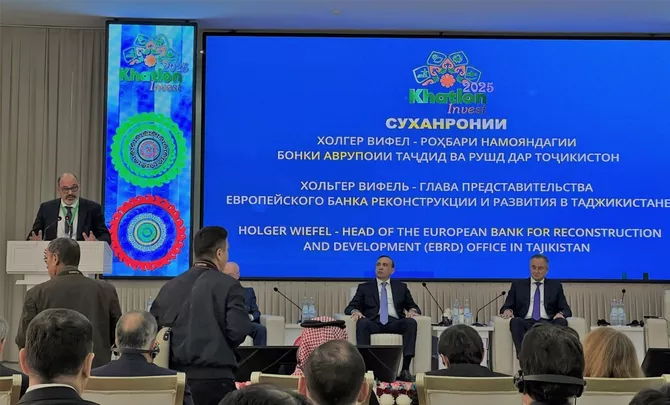EBRD Invests Over 1 Billion Euro in Tajikistan, Boosts Infrastructure and Regional Development – Caspian Post

EBRD Investment in Tajikistan: A Report on Contributions to Sustainable Development Goals
Executive Summary
The European Bank for Reconstruction and Development (EBRD) has established itself as Tajikistan’s largest institutional investor since commencing operations in 1993. With a total investment exceeding 1 billion euros across 185 projects, the bank’s strategy demonstrates a strong alignment with the United Nations Sustainable Development Goals (SDGs). Approximately 90 percent of this funding has been allocated to infrastructure development, directly contributing to improved living standards and sustainable economic growth.
Advancing Infrastructure, Innovation, and Sustainable Communities (SDG 9 & SDG 11)
The core of the EBRD’s portfolio in Tajikistan is dedicated to building resilient infrastructure, a cornerstone of SDG 9. This investment has modernized critical sectors and fostered sustainable urban development in line with SDG 11.
- Transport Modernization: Significant funds have been directed towards major road reconstruction projects, enhancing national and regional connectivity.
- Sustainable Urban Transit: The introduction of electric buses and digital public transit solutions promotes accessible and sustainable transport systems (Target 11.2).
- Digital Transformation: Investments in digital technologies support innovation and improve access to services.
Ensuring Access to Clean Water, Sanitation, and Environmental Health (SDG 6 & SDG 11)
A primary focus of the EBRD’s regional development strategy has been the improvement of essential public services, impacting over 20 percent of the population and directly addressing key SDG targets.
- Water and Sanitation (SDG 6): Numerous projects have been implemented to upgrade water supply and sanitation systems, ensuring greater access to clean water and sanitation for all.
- Waste Management (SDG 11): Investments in modern waste management infrastructure contribute to making cities more inclusive, safe, resilient, and sustainable by reducing their environmental impact (Target 11.6).
Promoting Decent Work, Economic Growth, and Gender Equality (SDG 8 & SDG 5)
While infrastructure forms the majority of the investment, 12 percent of funds are strategically channeled to foster inclusive economic growth and empower marginalized groups.
- Private Sector Development (SDG 8): Through partnerships with local financial institutions such as Bank Eskhata and Humo, the EBRD supports local businesses, particularly Small and Medium-sized Enterprises (SMEs), which are vital for job creation and sustained economic growth. Over 1,500 consulting projects have been executed to strengthen the private sector.
- Women’s Economic Empowerment (SDG 5): Collaboration with the Women Entrepreneurs Finance Initiative (We-Fi) specifically targets the enhancement of women’s roles in the economy, promoting gender equality.
Strengthening Partnerships for the Goals (SDG 17)
The EBRD’s success in Tajikistan is amplified through robust collaboration with international partners, embodying the spirit of SDG 17. These partnerships are crucial for mobilizing finance, technology, and expertise to achieve sustainable development.
- Switzerland
- Japan
- South Korea
- The European Union (EU)
Regional Impact: Khatlon Province Case Study
The Khatlon province serves as a prime example of the EBRD’s targeted regional development strategy. Since 2009, 16 projects totaling over 170 million euros have been implemented, focusing on critical upgrades that align with multiple SDGs, including SDG 6 (Clean Water and Sanitation), SDG 9 (Industry, Innovation and Infrastructure), and SDG 11 (Sustainable Cities and Communities).
Analysis of Sustainable Development Goals in the Article
1. Which SDGs are addressed or connected to the issues highlighted in the article?
The article highlights several issues and investment areas that directly connect to multiple Sustainable Development Goals (SDGs). Based on the focus on infrastructure, economic growth, and partnerships, the following SDGs are addressed:
- SDG 6: Clean Water and Sanitation – The article explicitly mentions investments in “water supply and sanitation.”
- SDG 8: Decent Work and Economic Growth – The text details support for “local businesses, particularly SMEs,” and efforts to “drive economic growth.”
- SDG 9: Industry, Innovation, and Infrastructure – This is a central theme, with the article stating that nearly 90% of funds are dedicated to “infrastructure,” including “road modernization” and “digital technologies.”
- SDG 11: Sustainable Cities and Communities – Investments in “public transportation,” “waste management,” and upgrades to “water supply systems” in urban and regional areas like Khatlon province are directly related to this goal.
- SDG 17: Partnerships for the Goals – The article emphasizes the EBRD’s role as an institutional investor and its collaboration with “international donors, including Switzerland, Japan, South Korea, the EU, and the Women Entrepreneurs Finance Initiative (We-Fi).”
2. What specific targets under those SDGs can be identified based on the article’s content?
The article’s content points to several specific targets under the identified SDGs:
- Under SDG 6:
- Target 6.1: Achieve universal and equitable access to safe and affordable drinking water for all. The investment in “water supply” systems directly supports this target.
- Target 6.2: Achieve access to adequate and equitable sanitation and hygiene for all. The focus on “sanitation” projects aligns with this target.
- Under SDG 8:
- Target 8.3: Promote development-oriented policies that support productive activities… and encourage the formalization and growth of micro-, small- and medium-sized enterprises (SMEs). The article mentions that 12% of investments target “the financial sector and local businesses, particularly SMEs” and the execution of “over 1,500 consulting projects” to strengthen the private sector.
- Under SDG 9:
- Target 9.1: Develop quality, reliable, sustainable and resilient infrastructure… to support economic development and human well-being. The article’s main focus is on infrastructure investments, including “road modernization” and “major road reconstruction projects.”
- Under SDG 11:
- Target 11.2: Provide access to safe, affordable, accessible and sustainable transport systems for all. This is addressed through investments in “public transportation,” including the “introduction of electric buses” and “digital public transit solutions.”
- Target 11.6: Reduce the adverse per capita environmental impact of cities, including by paying special attention to… municipal and other waste management. The mention of investments in “waste management” directly relates to this target.
- Under SDG 17:
- Target 17.3: Mobilize additional financial resources for developing countries from multiple sources. The EBRD’s investment of “more than 1 billion euros” and its collaboration with other international donors exemplify this.
- Target 17.16: Enhance the Global Partnership for Sustainable Development, complemented by multi-stakeholder partnerships. The EBRD’s long-term engagement in Tajikistan since 1993 and its partnerships with banks and international donors are a clear example of this target in action.
3. Are there any indicators mentioned or implied in the article that can be used to measure progress towards the identified targets?
The article provides several quantitative and qualitative points that can serve as indicators for measuring progress:
- Indicator for Targets 6.1 & 6.2: The article implies a measure of progress by stating that the investments are “providing better access to essential services for over 20 per cent of the population.” This suggests an indicator related to the proportion of the population with access to improved water and sanitation services.
- Indicator for Target 8.3: Progress can be measured by the “over 1,500 consulting projects” executed and the “more than 40 market development events” organized, which serve as metrics for support provided to the private sector and SMEs.
- Indicator for Target 9.1: The total financial commitment, “more than 1 billion euros” with “nearly 90 per cent of funds dedicated to infrastructure,” serves as a key financial indicator for infrastructure development. The implementation of “major road reconstruction projects” is a physical indicator of progress.
- Indicator for Target 11.2: The “introduction of electric buses” is a specific, measurable action that indicates progress towards sustainable transport systems.
- Indicator for Target 17.3: The total investment amount (“more than 1 billion euros”) and the number of projects (“185 projects”) are direct indicators of financial resources mobilized for development in Tajikistan.
4. Summary Table of SDGs, Targets, and Indicators
| SDGs | Targets | Indicators Identified in the Article |
|---|---|---|
| SDG 6: Clean Water and Sanitation | 6.1: Universal access to safe drinking water. 6.2: Access to adequate sanitation and hygiene. |
Providing better access to essential services (water supply and sanitation) for over 20% of the population. |
| SDG 8: Decent Work and Economic Growth | 8.3: Promote policies for productive activities and SME growth. | Execution of over 1,500 consulting projects and 40 market development events to strengthen the private sector. |
| SDG 9: Industry, Innovation, and Infrastructure | 9.1: Develop quality, reliable, and resilient infrastructure. | Investment of nearly 90% of 1 billion euros in infrastructure; implementation of road modernization and reconstruction projects. |
| SDG 11: Sustainable Cities and Communities | 11.2: Access to sustainable transport systems. 11.6: Reduce the environmental impact of cities (e.g., waste management). |
Introduction of electric buses and digital public transit solutions; investment in waste management systems. |
| SDG 17: Partnerships for the Goals | 17.3: Mobilize additional financial resources. 17.16: Enhance the Global Partnership for Sustainable Development. |
Total investment of over 1 billion euros across 185 projects; collaboration with international donors (Switzerland, Japan, South Korea, EU, We-Fi). |
Source: caspianpost.com
What is Your Reaction?
 Like
0
Like
0
 Dislike
0
Dislike
0
 Love
0
Love
0
 Funny
0
Funny
0
 Angry
0
Angry
0
 Sad
0
Sad
0
 Wow
0
Wow
0
















































/environment-climate-change-and-health-(ech)/water-sanitation-hygiene-and-health-(wsh)/landfill-tuvalu-36092.tmb-1200v.jpg?sfvrsn=5c21fe40_1#)

.jpg.webp?itok=0ZsAnae9#)

























